ABS SAAB 9-3 2009 Owners Manual
[x] Cancel search | Manufacturer: SAAB, Model Year: 2009, Model line: 9-3, Model: SAAB 9-3 2009Pages: 304, PDF Size: 44.31 MB
Page 6 of 304
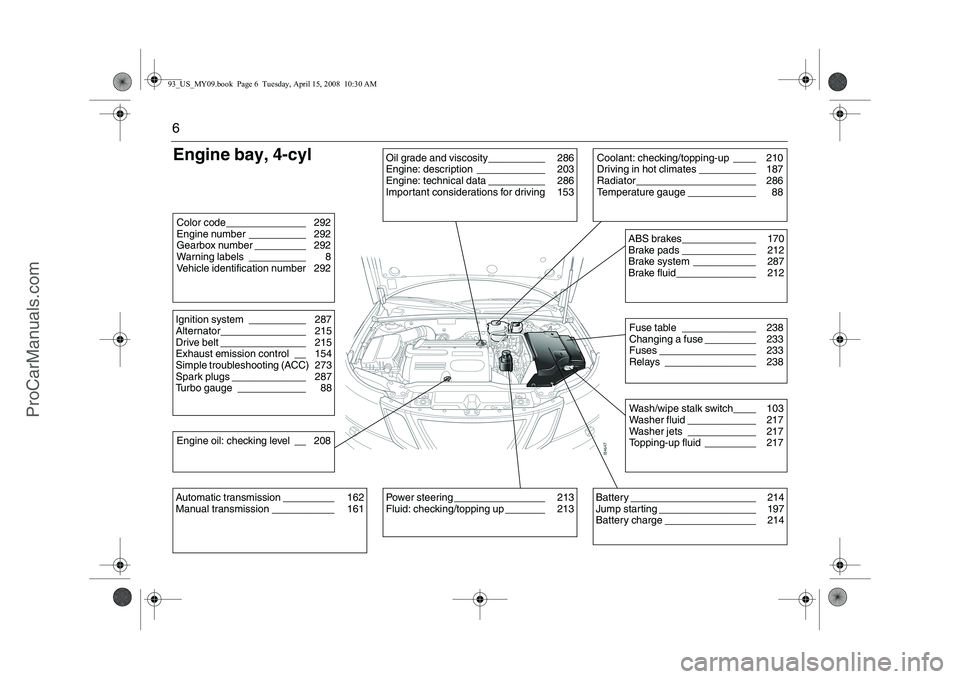
6Engine bay, 4-cylColor code______________ 292
Engine number __________ 292
Gearbox number _________ 292
Warning labels __________ 8
Vehicle identification number 292Ignition system __________ 287
Alternator_______________ 215
Drive belt _______________ 215
Exhaust emission control __ 154
Simple troubleshooting (ACC) 273
Spark plugs _____________ 287
Turbo gauge ____________ 88Engine oil: checking level __ 208Automatic transmission _________ 162
Manual transmission ___________ 161
Battery ______________________ 214
Jump starting _________________ 197
Battery charge ________________ 214
Oil grade and viscosity__________ 286
Engine: description ____________ 203
Engine: technical data __________ 286
Important considerations for driving 153
Wash/wipe stalk switch____ 103
Washer fluid ____________ 217
Washer jets ____________ 217
Topping-up fluid _________ 217
Power steering ________________ 213
Fluid: checking/topping up _______ 213
Coolant: checking/topping-up ____ 210
Driving in hot climates __________ 187
Radiator _____________________ 286
Temperature gauge ____________ 88
Fuse table _____________ 238
Changing a fuse _________ 233
Fuses _________________ 233
Relays ________________ 238ABS brakes_____________ 170
Brake pads _____________ 212
Brake system ___________ 287
Brake fluid______________ 212
93_US_MY09.book Page 6 Tuesday, April 15, 2008 10:30 AM
ProCarManuals.com
Page 7 of 304
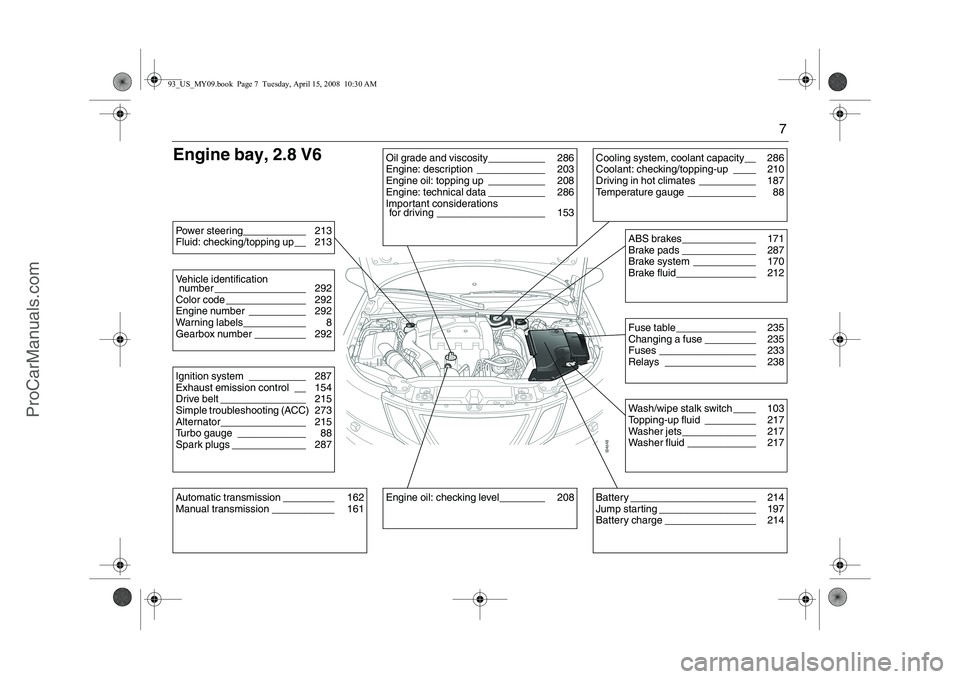
7
Engine bay, 2.8 V6Power steering___________ 213
Fluid: checking/topping up__ 213Vehicle identification
number ________________ 292
Color code ______________ 292
Engine number __________ 292
Warning labels___________ 8
Gearbox number _________ 292Ignition system __________ 287
Exhaust emission control __ 154
Drive belt _______________ 215
Simple troubleshooting (ACC) 273
Alternator_______________ 215
Turbo gauge ____________ 88
Spark plugs _____________ 287Automatic transmission _________ 162
Manual transmission ___________ 161
Oil grade and viscosity__________ 286
Engine: description ____________ 203
Engine oil: topping up __________ 208
Engine: technical data __________ 286
Important considerations
for driving ___________________ 153Engine oil: checking level________ 208
Battery ______________________ 214
Jump starting _________________ 197
Battery charge ________________ 214
Wash/wipe stalk switch ____ 103
Topping-up fluid _________ 217
Washer jets_____________ 217
Washer fluid ____________ 217Fuse table ______________ 235
Changing a fuse _________ 235
Fuses _________________ 233
Relays ________________ 238ABS brakes_____________ 171
Brake pads _____________ 287
Brake system ___________ 170
Brake fluid______________ 212
Cooling system, coolant capacity__ 286
Coolant: checking/topping-up ____ 210
Driving in hot climates __________ 187
Temperature gauge ____________ 88
93_US_MY09.book Page 7 Tuesday, April 15, 2008 10:30 AM
ProCarManuals.com
Page 10 of 304
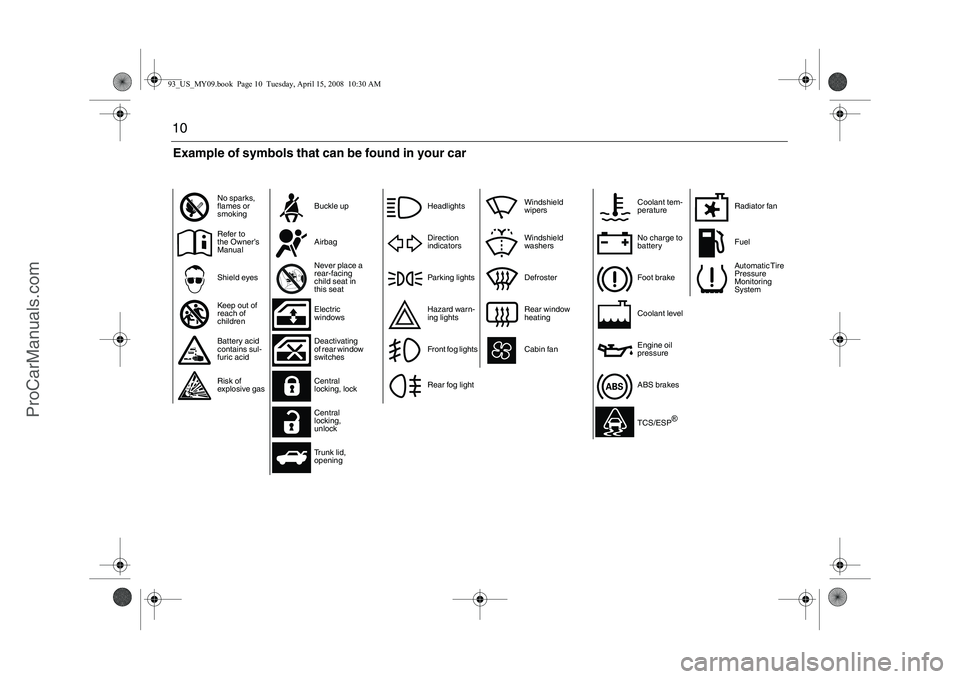
10
No sparks,
flames or
smokingBuckle up
Refer to
the Owner’s
ManualAirbag
Shield eyesNever place a
rear-facing
child seat in
this seat
Keep out of
reach of
childrenElectric
windows
Battery acid
contains sul-
furic acidDeactivating
of rear window
switches
Risk of
explosive gasCentral
locking, lock
Central
locking,
unlock
Trunk lid,
opening
HeadlightsWindshield
wipers
Direction
indicatorsWindshield
washers
Parking lights Defroster
Hazard warn-
ing lightsRear window
heating
Front fog lights Cabin fan
Rear fog light
Coolant tem-
peratureRadiator fan
No charge to
batteryFuel
Foot brakeAutomatic Tire
Pressure
Monitoring
System
Coolant level
Engine oil
pressure
ABS brakes
TCS/ESP
®
Example of symbols that can be found in your car93_US_MY09.book Page 10 Tuesday, April 15, 2008 10:30 AM
ProCarManuals.com
Page 16 of 304

16 SafetySafety belt pretensioners
SportSedan and SportCombi: The front
safety belts are equipped with pretension-
ers and force limiters. The pretensioners
are activated in the event of a violent frontal
or side-on crash. The safety belt pretension-
ers are only activated if the safety belt in
question is in use but not activated should
the car roll over.
The safety belt pretensioners serve to
reduce the forward movement of the body
by tensioning the belt. The force limiters
reduce belt loads on the body by "slacken-
ing" the safety belt slightly to absorb the
body’s kinetic energy as gradually as possi-
ble.Convertible: The front and rear safety belts
are equipped with pretensioners and force
limiters. The pretensioners are activated in
the event of a violent frontal or side-on
crash. The front safety belt pretensioners
are only activated if the safety belt in ques-
tion is in use.
The safety belt pretensioners serve to
reduce the movement of the body by ten-
sioning the belt, including in a roll over
crash. The force limiters reduce belt loads
on the body by "slackening" the safety belt
slightly to absorb the body’s kinetic energy
as gradually as possible.
WARNING
If the car is involved in a crash, the safety
belts, belt pretensioners and other com-
ponents must be inspected and replaced
as necessary. We recommend that you
contact a Saab dealer.
Never make any alterations or repairs to
the safety belt yourself. We recommend
that you contact a Saab dealer for any
necessary repairs.93_US_MY09.book Page 16 Tuesday, April 15, 2008 10:30 AM
ProCarManuals.com
Page 40 of 304
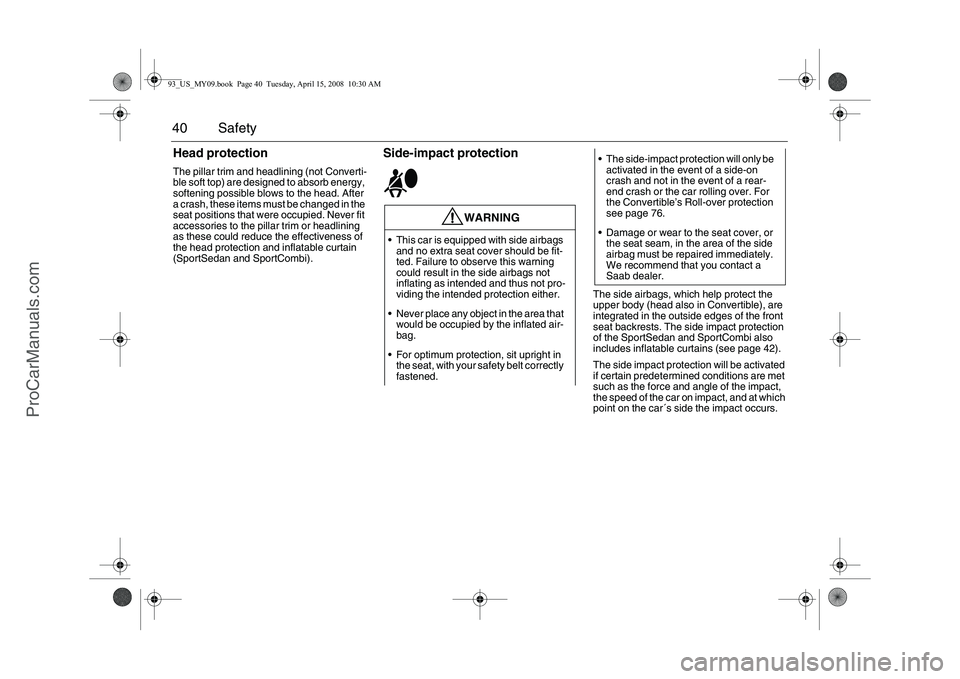
40 SafetyHead protectionThe pillar trim and headlining (not Converti-
ble soft top) are designed to absorb energy,
softening possible blows to the head. After
a crash, these items must be changed in the
seat positions that were occupied. Never fit
accessories to the pillar trim or headlining
as these could reduce the effectiveness of
the head protection and inflatable curtain
(SportSedan and SportCombi).
Side-impact protection
The side airbags, which help protect the
upper body (head also in Convertible), are
integrated in the outside edges of the front
seat backrests. The side impact protection
of the SportSedan and SportCombi also
includes inflatable curtains (see page 42).
The side impact protection will be activated
if certain predetermined conditions are met
such as the force and angle of the impact,
the speed of the car on impact, and at which
point on the car´s side the impact occurs.
WARNING
This car is equipped with side airbags
and no extra seat cover should be fit-
ted. Failure to observe this warning
could result in the side airbags not
inflating as intended and thus not pro-
viding the intended protection either.
Never place any object in the area that
would be occupied by the inflated air-
bag.
For optimum protection, sit upright in
the seat, with your safety belt correctly
fastened.
The side-impact protection will only be
activated in the event of a side-on
crash and not in the event of a rear-
end crash or the car rolling over. For
the Convertible’s Roll-over protection
see page 76.
Damage or wear to the seat cover, or
the seat seam, in the area of the side
airbag must be repaired immediately.
We recommend that you contact a
Saab dealer.
93_US_MY09.book Page 40 Tuesday, April 15, 2008 10:30 AM
ProCarManuals.com
Page 82 of 304
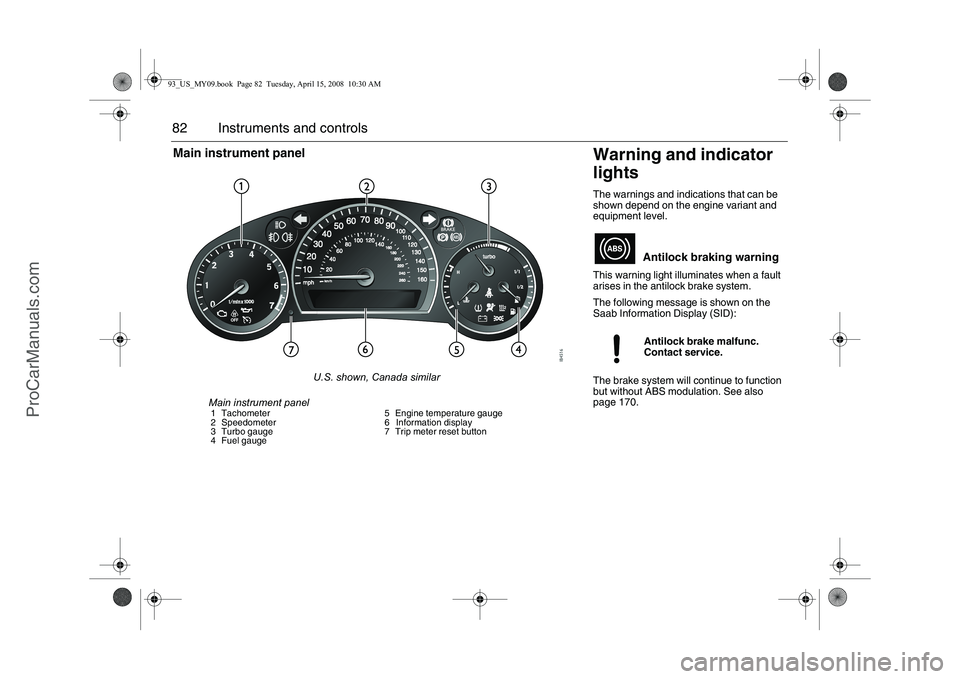
82 Instruments and controls
Warning and indicator
lightsThe warnings and indications that can be
shown depend on the engine variant and
equipment level.
This warning light illuminates when a fault
arises in the antilock brake system.
The following message is shown on the
Saab Information Display (SID):
The brake system will continue to function
but without ABS modulation. See also
page 170.
Antilock braking warningAntilock brake malfunc.
Contact service.
Main instrument panel1 Tachometer
2 Speedometer
3 Turbo gauge
4 Fuel gauge5 Engine temperature gauge
6 Information display
7 Trip meter reset button
Main instrument panel
U.S. shown, Canada similar
93_US_MY09.book Page 82 Tuesday, April 15, 2008 10:30 AM
ProCarManuals.com
Page 87 of 304

87 Instruments and controls
Autochecking of lights, main
instrument panelThe warning and indicator lights shown
above should come on when the ignition
switch is turned to ON. They should go out
after about 4 seconds once the engine has
started or after the fault-free self-diagnosis
of each system or function.
InstrumentsTachometerThe tachometer displays the engine speed
in thousands of revolutions per minute.
A protective function (interruption of the fuel
supply) limits the engine speed within the
red zone.
Speedometer (U.S. speedometer shown)
Cars sold in U.S.: The speedometer dis-
plays the speed of the car in miles per hour
(mph).
Cars sold in Canada: The speedometer
displays the speed of the car in kilometres
per hour (km/h).
It receives information about vehicle speed
from the ABS’s wheel sensors.
93_US_MY09.book Page 87 Tuesday, April 15, 2008 10:30 AM
ProCarManuals.com
Page 150 of 304
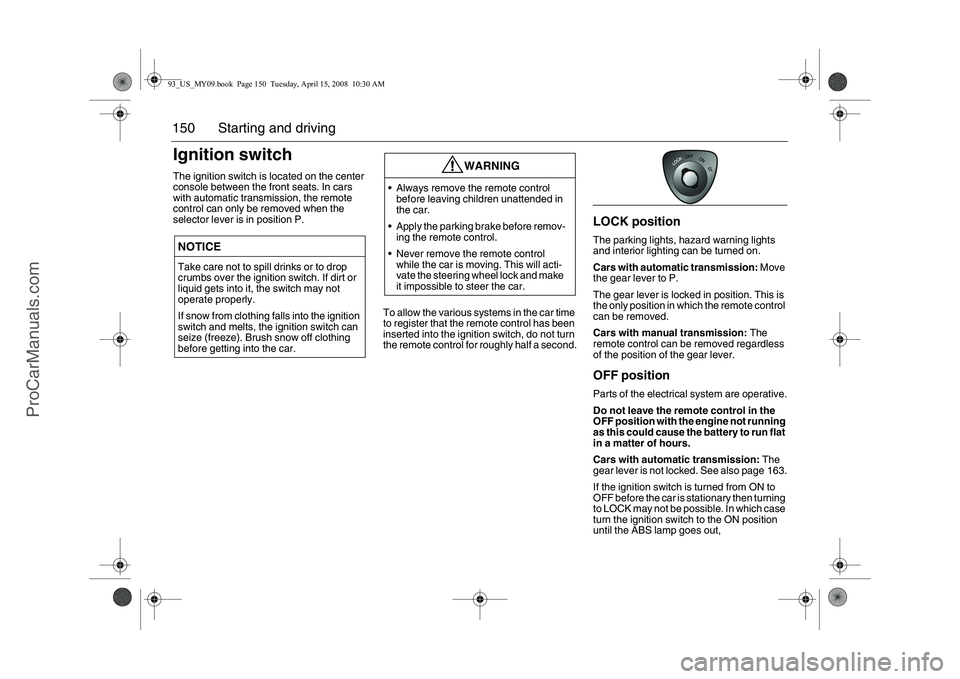
150 Starting and drivingIgnition switchThe ignition switch is located on the center
console between the front seats. In cars
with automatic transmission, the remote
control can only be removed when the
selector lever is in position P.
To allow the various systems in the car time
to register that the remote control has been
inserted into the ignition switch, do not turn
the remote control for roughly half a second.
LOCK positionThe parking lights, hazard warning lights
and interior lighting can be turned on.
Cars with automatic transmission: Move
the gear lever to P.
The gear lever is locked in position. This is
the only position in which the remote control
can be removed.
Cars with manual transmission: The
remote control can be removed regardless
of the position of the gear lever.OFF positionParts of the electrical system are operative.
Do not leave the remote control in the
OFF position with the engine not running
as this could cause the battery to run flat
in a matter of hours.
Cars with automatic transmission: The
gear lever is not locked. See also page 163.
If the ignition switch is turned from ON to
OFF before the car is stationary then turning
to LOCK may not be possible. In which case
turn the ignition switch to the ON position
until the ABS lamp goes out,
NOTICETake care not to spill drinks or to drop
crumbs over the ignition switch. If dirt or
liquid gets into it, the switch may not
operate properly.
If snow from clothing falls into the ignition
switch and melts, the ignition switch can
seize (freeze). Brush snow off clothing
before getting into the car.
WARNING
Always remove the remote control
before leaving children unattended in
the car.
Apply the parking brake before remov-
ing the remote control.
Never remove the remote control
while the car is moving. This will acti-
vate the steering wheel lock and make
it impossible to steer the car.
93_US_MY09.book Page 150 Tuesday, April 15, 2008 10:30 AM
ProCarManuals.com
Page 171 of 304
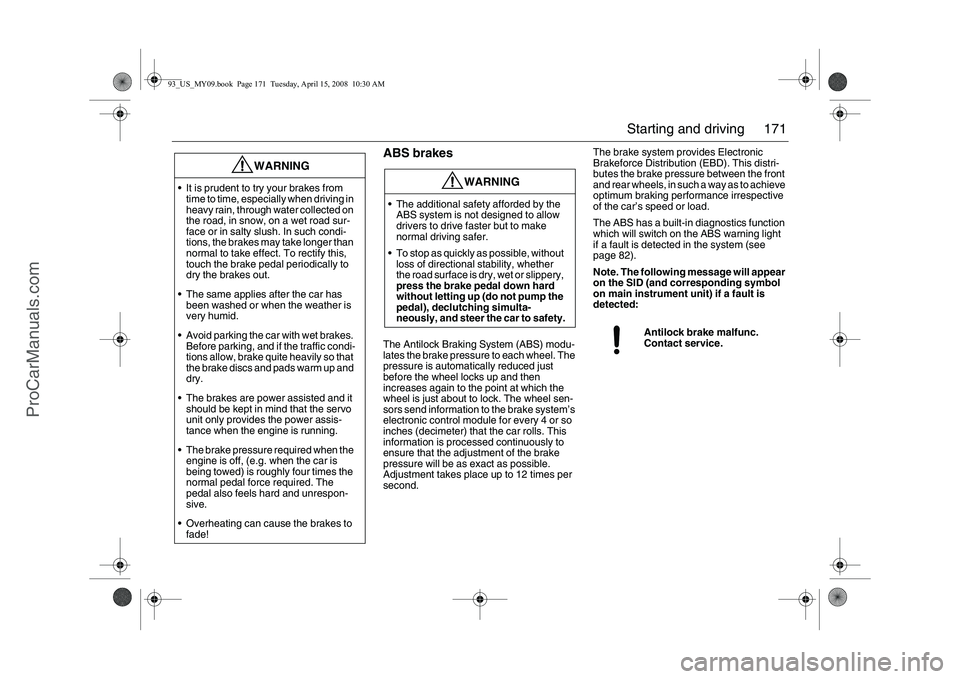
171 Starting and driving
ABS brakesThe Antilock Braking System (ABS) modu-
lates the brake pressure to each wheel. The
pressure is automatically reduced just
before the wheel locks up and then
increases again to the point at which the
wheel is just about to lock. The wheel sen-
sors send information to the brake system’s
electronic control module for every 4 or so
inches (decimeter) that the car rolls. This
information is processed continuously to
ensure that the adjustment of the brake
pressure will be as exact as possible.
Adjustment takes place up to 12 times per
second.The brake system provides Electronic
Brakeforce Distribution (EBD). This distri-
butes the brake pressure between the front
and rear wheels, in such a way as to achieve
optimum braking performance irrespective
of the car’s speed or load.
The ABS has a built-in diagnostics function
which will switch on the ABS warning light
if a fault is detected in the system (see
page 82).
Note. The following message will appear
on the SID (and corresponding symbol
on main instrument unit) if a fault is
detected:
WARNING
It is prudent to try your brakes from
time to time, especially when driving in
heavy rain, through water collected on
the road, in snow, on a wet road sur-
face or in salty slush. In such condi-
tions, the brakes may take longer than
normal to take effect. To rectify this,
touch the brake pedal periodically to
dry the brakes out.
The same applies after the car has
been washed or when the weather is
very humid.
Avoid parking the car with wet brakes.
Before parking, and if the traffic condi-
tions allow, brake quite heavily so that
the brake discs and pads warm up and
dry.
The brakes are power assisted and it
should be kept in mind that the servo
unit only provides the power assis-
tance when the engine is running.
The brake pressure required when the
engine is off, (e.g. when the car is
being towed) is roughly four times the
normal pedal force required. The
pedal also feels hard and unrespon-
sive.
Overheating can cause the brakes to
fade!
WARNING
The additional safety afforded by the
ABS system is not designed to allow
drivers to drive faster but to make
normal driving safer.
To stop as quickly as possible, without
loss of directional stability, whether
the road surface is dry, wet or slippery,
press the brake pedal down hard
without letting up (do not pump the
pedal), declutching simulta-
neously, and steer the car to safety.
Antilock brake malfunc.
Contact service.
93_US_MY09.book Page 171 Tuesday, April 15, 2008 10:30 AM
ProCarManuals.com
Page 172 of 304
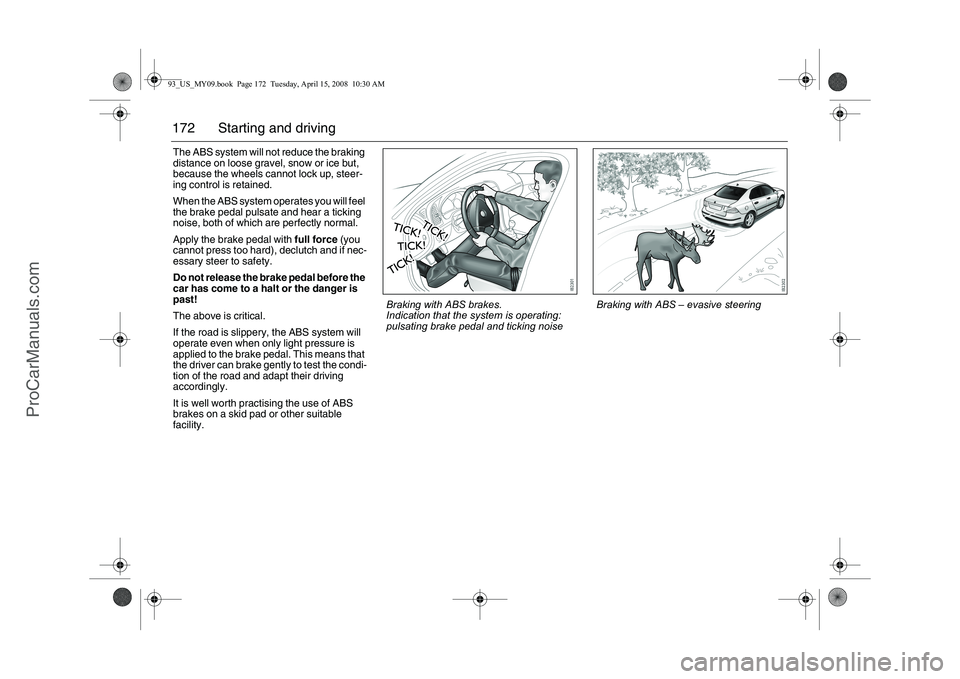
172 Starting and drivingThe ABS system will not reduce the braking
distance on loose gravel, snow or ice but,
because the wheels cannot lock up, steer-
ing control is retained.
When the ABS system operates you will feel
the brake pedal pulsate and hear a ticking
noise, both of which are perfectly normal.
Apply the brake pedal with full force (you
cannot press too hard), declutch and if nec-
essary steer to safety.
Do not release the brake pedal before the
car has come to a halt or the danger is
past!
The above is critical.
If the road is slippery, the ABS system will
operate even when only light pressure is
applied to the brake pedal. This means that
the driver can brake gently to test the condi-
tion of the road and adapt their driving
accordingly.
It is well worth practising the use of ABS
brakes on a skid pad or other suitable
facility.
Braking with ABS – evasive steering
Braking with ABS brakes.
Indication that the system is operating:
pulsating brake pedal and ticking noise
93_US_MY09.book Page 172 Tuesday, April 15, 2008 10:30 AM
ProCarManuals.com